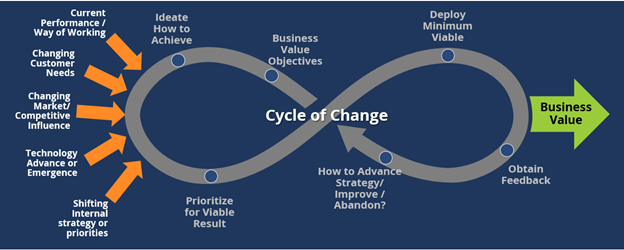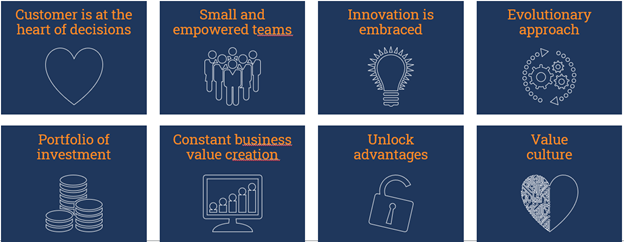When I was at lunch recently with the Head of IT for a global engineering firm, I heard about the lack of innovation from her technology staff and partners. “We have a digital transformation going on, but it’s really the only place where any innovation is taking place – besides,” she tells me, “only a small portion of the organization is on the transformation project. Everyone else is just working in the current environment.”
“Current” environment? Transformation “project”? This sounded like transformation was a task on a checklist. Yet, in my experience, transformation is constant. Will we ever be fully transformed? Will we ever have a fully modern environment? When, exactly, is the future of our future state? Will we ever be in a position where we have no technical or skill debt?
When we think of all the reasons that lead to transformation, we realize it really comes down to the constant cycle of change. Whether the reason for change is based on internal or external pressure or influence, we are essentially always responding to influences that cause us to shift – to transform – to sustain or generate different, more or new business value.

Figure 1: Continuous Transformation
Ensuring innovative change that produces tangible results
As we define the objective of change and ideate how to achieve it, the key is that the ideas and opportunities are innovative, new, outside-the-box, maybe even somewhat risky. Yet, at the same time, change efforts need to produce tangible business value. This is the inherent result of transformation: innovative change that produces tangible results. And this applies whether the transformation is sustaining, incremental, disruptive or radical. But how do we foster our organization to address transformation continuously?
During a recent engagement, we helped one of our clients recognize that their digital transformation was more an evolution than a revolution. We helped them embrace the idea that transformation itself is continuous. Why is this important? Like most organizations, this one had an aging technology environment with rampant technical debt, a lack of modern skills within their workforce and ways of working that were disconnected from the business value and customer experience they were intended to enable. And, like most companies, it had no wealth of funding available to address its needs, modernize its environments and workforce or transform. And while it might have a vision of the future, that future was (and was likely to remain) somewhat fuzzy. The closer you get to the future, the clearer it becomes – and yet it also grows and changes over time. So, while that short-term future vision gets clearer, a longer-term future is always growing and expanding on the horizon.
Effectively, we never really reach an “end state.”
Rethinking digital transformation by redefining change
One goal we have is to help the client’s organization feel comfortable and to just simply start changing. When enterprises set an expectation that transformation will happen or be accomplished by a specific end state, they tend to spend a lot of time defining that end state. After all, they want it to be correct so that they we don’t waste time and so they will know when they get there. Not to mention how much investment was required to get there.
Yet when an organization can acknowledge that it will never really reach an end state, but that the end state is constantly changing, then it tends to feel more comfortable starting without having a pristine vision. Even starting without a giant bucket of funding. It also allows the organization to acknowledge, recognize and expect that the vision will change and expand over time, and to harvest cost savings along the way to push back into the cycle of change as additional investment.
To enable this particular client to foster transformation day in and day out, we established a framework of principles to foster this mentality. These principles, and their underlying list of guidelines, created an environment that helped foster continuous transformation that became the core of the company’s operating model.

Figure 2: Is Your Operating Model Fostering Continuous Change?
The 8 principles of an operating model for continuous change
- Place the customer at the heart of decision-making: Introduce product-oriented and business-aligned delivery, focus on customer feedback as a core measure, expect customer wants and needs to change, use “delight” as an objective of that customer feedback, and align the incentives of the organization to that objective.
- Use small and empowered teams: Build persistent teams of cross-functional skills focused on a particular business function or part of the customer journey. Give teams responsibility and accountability to constantly improve themselves and their performance. Encourage – even incentivize – a test-and-learn mentality. This ensures that transformation doesn’t just address one customer stage or function but all of them.
- Embrace innovative ideas: Practice servant leadership, establish psychological safety to promote ideation to come from everywhere and everyone. Encourage a minimum viable mindset, in which ideas are tested just enough to determine their viability and then are ruthlessly abandoned or vigorously expanded. Aim for teams (and leaders!) to be comfortable with change and with some degree of risk, and reward / acknowledge / celebrate / replicate innovative ideas.
- Apply an evolutionary approach: Evolve architectures using strangling patterns instead of wholesale replacement wherever possible. Seek out emerging technologies for applicability, seek and try accelerators – tools, methodologies, capabilities – of transformation and iterate using agile concepts even for those large-scale architecture and foundational changes. Think big, start small, scale fast – but start.
- Use a portfolio of investment: Use an agile funding model that includes more but smaller bets, minimum viable investments, early value creation and brutal abandonment. Diversify by funding across the portfolio and by spreading investment across both consumption and asset approaches, stop overrating sunk costs and expect constant priority shifts.
- Create business value constantly: Measure and track business value creation from the business case through realization, make your bets smaller but business-value focused, set early and brutal value achievement requirements (or pull funding), expect your business value indicators to change over time and capture intangibles.
- Unlock inherent advantages: Use business data to recognize shifts and the need for change, reward and value results over procedures, acknowledge all ideas – even those that fail – and get out of the way. This means limiting bureaucracy and the number of decision points and decision-makers.
- Make value your culture: Valuing something means to think about it, talk about it, measure it, improve it, celebrate it. Value your employees, value your customers, value your technologies, value ideas, value changes and remain forward-looking.
For this client, transforming to a more digitally enabled customer experience was the aim. These core principles helped the client establish a culture of continuous transformation – and helped make innovation and transformative change an inherent part of everything they do. We also established a performance framework around the principles and continue to measure the perception of maturity within each principle over time – as principles themselves should be subject to transformation on our continuous change journey.
I shared this concept with my lunch date and, after some contemplation, she’s now using these as a core part of her company’s digital transformation journey. This approach also helped her begin to shake loose the dual modes of “current state” and “transformation project” within her organization’s ways of working. Now everyone is involved in transformation. And she reports that innovation is now becoming the norm rather than the exception.
ISG helps enterprises design transformation strategies and build adaptive operating models. Join me at the ISG Digital Business Summit in London where I will be exploring these and other questions about how to build continuous transformation and an adaptive organization. Or contact us directly to find out how ISG can help you.
